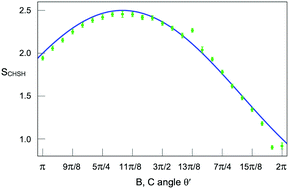Bell inequalities for entangled qubits: quantitative tests of quantum character and nonlocality on quantum computers
Abstract
This work provides quantitative tests of the extent of violation of two inequalities applicable to qubits coupled into Bell states, using IBM's publicly accessible quantum computers. Violations of the inequalities are well established. Our purpose is not to test the inequalities, but rather to determine how well quantum mechanical predictions can be reproduced on quantum computers, given their current fault rates. We present results for the spin projections of two entangled qubits, along three axes A, B, and C, with a fixed angle θ between A and B and a range of angles θ′ between B and C. For any classical object that can be characterized by three observables with two possible values, inequalities govern relationships among the probabilities of outcomes for the observables, taken pairwise. From set theory, these inequalities must be satisfied by all such classical objects; but quantum systems may violate the inequalities. We have detected clear-cut violations of one inequality in runs on IBM's publicly accessible quantum computers. The Clauser–Horne–Shimony–Holt (CHSH) inequality governs a linear combination S of expectation values of products of spin projections, taken pairwise. Finding S > 2 rules out local, hidden variable theories for entangled quantum systems. We obtained values of S greater than 2 in our runs prior to error mitigation. To reduce the quantitative errors, we used a modification of the error-mitigation procedure in the IBM documentation. We prepared a pair of qubits in the state |00〉, found the probabilities to observe the states |00〉, |01〉, |10〉, and |11〉 in multiple runs, and used that information to construct the first column of an error matrix M. We repeated this procedure for states prepared as |01〉, |10〉, and |11〉 to construct the full matrix M, whose inverse is the filtering matrix. After applying filtering matrices to our averaged outcomes, we have found good quantitative agreement between the quantum computer output and the quantum mechanical predictions for the extent of violation of both inequalities as functions of θ′.

- This article is part of the themed collections: Quantum computing and quantum information storage: Celebrating the 2022 Nobel Prize in Physics and Quantum Computing and Quantum Information Storage


 Please wait while we load your content...
Please wait while we load your content...